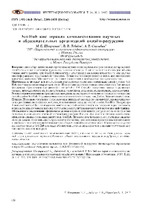| dc.contributor.author | Шварцман, М. Е. | |
| dc.contributor.author | Лебедев, В. В. | |
| dc.contributor.author | Скалабан, А. В. | |
| dc.date.accessioned | 2017-12-07T08:46:07Z | |
| dc.date.available | 2017-12-07T08:46:07Z | |
| dc.date.issued | 2015 | |
| dc.identifier.citation | Шварцман, М. Е. Sci-Hub как зеркало комплектования научных и образовательных организаций онлайн-ресурсами / М. Е. Шварцман, В. В. Лебедев, А. В. Скалабан // Интеграция образования. – 2017. – Т. 21, № 3. – С. 522-534. | ru |
| dc.identifier.uri | https://rep.bntu.by/handle/data/35273 | |
| dc.description.abstract | Введение: для выбора оптимальной стратегии комплектования научных и образовательных учреждений онлайн-ресурсами необходимо использовать новые подходы. В качестве одного из них российские ученые могут выбрать сайт Sci-Hub как наиболее доступный в настоящее время ресурс для получения информации о зарубежных публикациях. Целью исследования является поиск дополнительных критериев оценки онлайн-ресурсов для принятия решения о необходимости подписки на них. Материалы и методы: для исследования использована статистика скачивания статей с сайта Sci-Hub, опубликованная в открытом доступе. Из нее были выделены данные, относящиеся к Российской Федерации. При помощи программного интерфейса API CrossRef получены данные о скачанных статьях, проведен анализ их распределения по тематикам, регионам, годам издания, издательствам. Результаты исследования: приведенные материалы характеризуют масштаб нелегального скачивания статей с сайта Sci-Hub. Выделены данные по таким научным центрам, как Дубна, Черноголовка, Саров, Пущино. Проведено сравнение статистических данных по легальному скачиванию, производящемуся из доступных по подписке ресурсов, и нелегальной загрузке статей с сайта Sci-Hub. На примере American Chemical Society выделены наиболее востребованные журналы, показана недостаточность комплектования научных центров и отсутствие взаимодействия институтов в получении информации. Обсуждение и заключения: официальные данные о применении онлайн-ресурсов далеко не полностью отражают использование научной информации учеными России. Для полноты картины необходимо привлекать данные статистики выгрузок из Sci-Hub. Практическая значимость исследования заключается в возможности использовать приведенную статистику для выявления пробелов в комплектовании и проблем в организации информационного обеспечения образования и науки. Предложены создание легального аналога Sci-Hub и методы обеспечения доступа пользователей к онлайн-ресурсам из любого места, где есть интернет. | ru |
| dc.language.iso | ru | ru |
| dc.title | Sci-Hub как зеркало комплектования научных и образовательных организаций онлайн-ресурсами | ru |
| dc.title.alternative | Sci-Hub as a Mirror of Research and Educational Institutions’ Acquisition of E-resources | en |
| dc.type | Article | ru |
| local.description.annotation | Introduction: new approaches are required to select the optimal strategy of e-resources acquisition. The aim of the study is to find additional criteria for evaluating online resources, to decide whether to subscribe to these resources. To analyze the real needs of researchers and estimate usability of scholarly resources we propose to use the statistics of downloads from the Sci-Hub website as the most accessible resource nowadays. We presume the requests to Sci-Hub demonstrate the real needs of scientists, pedagogical staff, postgraduate and students in the science articles. Materials and Methods: using open statistics on the Sci-Hub website, we extracted the dataset referred to the Russian Federation. We obtained the data on the downloaded articles with the API CrossrRef and analyzed distribution of the articles over topics, regions, years of publication and publishers. Results: we present tables, graphs and diagrams illustrated the extent of illegal downloading from the Sci-Hub website. The data on Dubna, Chernogolovka, Sarov, Puschino research centers is highlighted. The legal and illegal download statistics are compared. Discussion and Conclusions: official data on use of e-resources in universities appears incomplete with out evaluation of the Sci-Hub downloads. The practical significance of the study lies in the ability to use the above statistics to identify gaps in acquisition and problems in the organization of information support for education and science. The Sci-Hub factor should be taken into account in the information support for research and education. This article describes methods to improve the usability of online resources and American Chemical Society was used as an example. The most requested chemical journals in Sci-Hub were selected. Statistics demonstrates insufficiency of the acquisition of scientific centers with chemical journals, and the problems of cooperation among institutions in obtaining information. It is proposed to create a legal analogue of Sci-Hub and methods for providing users with access to online resources subscribed by their institutions worldwide. | en |

